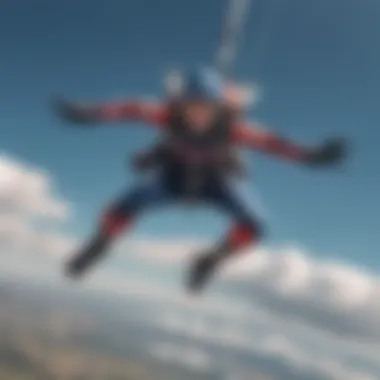Mastering Anchored Performance in Extreme Sports


Intro
Extreme sports encompass a wide range of high-adrenaline activities that demand both mental and physical expertise. The concept of anchored performance is especially relevant in these sports, as participants must navigate intense challenges and extreme conditions. This article explores how effective preparation and adaptive strategies can not only enhance performance but also foster resilience amid the unpredictability inherent in extreme sports.
Anchored performance goes beyond mere skill; it integrates mental focus, the ability to adapt to changing situations, and the discipline to maintain composure under pressure. Athletes in disciplines such as rock climbing, base jumping, or extreme skiing must develop a unique mindset to achieve peak performance while also managing risks.
Extreme Sports Overview
Definition of Extreme Sports
Extreme sports refer to activities that involve a high degree of risk, requiring advanced skills and physical endurance. These sports often take place in dramatic environments and are characterized by their exhilarating nature. Typical examples include skateboarding, snowboarding, and surfing.
History and Evolution
The roots of extreme sports can be traced back to the mid-20th century when enthusiasts began pushing the limits of conventional sports. Over decades, these activities attracted attention from outside the traditional sports community. As a result, extreme sports evolved into mainstream competitions, with the X Games and other events highlighting their growth.
Popular Extreme Sports Disciplines
Several disciplines stand out within the extreme sports landscape:
- Rock Climbing: This sport tests physical strength and mental focus.
- Base Jumping: Involves jumping from fixed objects with a parachute.
- Snowboarding: Combines the thrill of downhill racing with artistic components.
- Surfing: An age-old sport that demands physical skill and environmental awareness.
Gear and Equipment
Essential Gear for Different Sports
The right gear is paramount in extreme sports. Each discipline has specific equipment designed to maximize safety and performance. For instance, rock climbers rely on harnesses and climbing shoes, while snowboarders need bindings and helmets.
Gear Reviews and Comparisons
Evaluating gear quality can significantly impact performance. Brands like Black Diamond and Burton offer trusted options in climbing and snowboarding gear, respectively. Each brand's offerings come with various features that cater to different skill levels and preferences.
Safety Ratings and Certifications
Safety should never be neglecte. Gear must meet specific industry standards. Certifications from organizations such as the American National Standards Institute provide assurance that equipment is reliable and safe for use.
Training and Preparation
Physical Conditioning and Fitness Tips
Achieving peak performance in extreme sports requires rigorous physical conditioning. Strength training, cardiovascular workouts, and flexibility exercises can build the necessary physical foundation.
Mental Preparation Techniques
Mental clarity is vital in high-stakes situations. Techniques such as visualization and meditation can enhance focus and mitigate anxiety. By practicing these methods, athletes learn to center their thoughts and prepare for the challenges that lie ahead.
Training Regimens for Various Sports
Training must be tailored according to the sport. For example, climbers often use bouldering to improve strength, while surfers may practice paddling techniques to enhance endurance. Adapting training regimens to specific disciplines ensures that athletes are well-prepared for competition.
Locations and Destinations
Top Destinations for Extreme Sports
Certain locations have gained fame for their extreme sports opportunities. Places like the Swiss Alps for skiing, Hawaii for surfing, and Arches National Park for rock climbing attract thrill-seekers from around the world.
Travel Tips and Guides
Planning a trip for extreme sports requires attention to details. Researching local regulations, weather conditions, and available facilities can ensure a successful experience. Additionally, investing in local guides can enhance safety and provide insider knowledge.
Understanding Anchored Performance
Understanding the core elements of anchored performance is crucial for athletes, particularly those engaged in extreme sports. The concept encompasses both mental and physical strategies employed to enhance performance under varying conditions. Its significance lies in the ability to streamline focus, maintain composure, and achieve desired outcomes in high-pressure situations, a common scenario for extreme sports enthusiasts.
Concept of Anchored Performance
Anchored performance refers to the mental state wherein an athlete can align their focus and actions effectively to catalyze peak performance. This involves establishing mental cues or anchors that solidify concentration during complex tasks or when faced with stressors. The formation of these anchors can enhance an athlete's ability to stay present and responsive to immediate challenges, especially in unpredictable environments such as surfing or rock climbing.
A well-defined anchor can be anything from a physical gesture to a phrase that reminds the athlete of their intent. By regularly practicing these cues, they can be triggered even in high-stress moments, leading to better decision-making and improved execution of skills. This targeted focus not only optimizes performance but also fosters confidence as the athlete learns to trust their instincts and training.
Historical Context within Sports Psychology
Anchored performance has roots in sports psychology dating back to the mid-20th century when psychologists began to recognize the profound impact of mental states on athletic outcomes. Early research tackled concepts like visualization and self-talk. However, it was sports psychologists like Barbara E. Smolka who pioneered the understanding of performance anchoring. They introduced the idea that athletes could enhance their mental state through intentional practices that help manage anxiety and promote focus.
Over the decades, numerous studies have explored the significance of mental preparation. Techniques emerged, solidifying their relevance in extreme sports. Athletes started adopting methods learned from cognitive-behavioral frameworks alongside classic resilience training to prevent performance drops. This historical progression underscores the evolution of mental strategies as more than secondary, but rather pivotal in competitive sports.


Application to Extreme Sports
Applying anchored performance principles to extreme sports is particularly beneficial given the unique pressures these activities present. Whether it's skydiving, BASE jumping, or extreme skiing, athletes face not only physical challenges but also significant psychological ones. High-stakes environments require pinpoint precision and the ability to adapt quickly.
Extreme sports athletes benefit remarkably from integrating mental anchors. For example, a skydiver may use a specific breathing technique as an anchor before leaping. This allows them to maintain calmness and enhance focus just prior to the jump. Similarly, in surfing, riders could use an internal mantra that reinforces confidence as they face powerful waves.
By embedding these techniques into regular training, athletes cultivate resilience and adaptability. The repeated practice of their anchors serves to automate coping mechanisms, resulting in more reliable performances when it counts. This intersection of mind and body through anchored performance transforms how athletes approach their sport, ultimately leading to improved results and personal satisfaction.
The Psychology of Performance Anchoring
Understanding the psychology behind performance anchoring is essential for anyone involved in extreme sports. It offers insights into how mental states can influence physical performance. At its core, anchored performance is about establishing psychological anchors that stabilize an athlete's focus and emotional responses during high-stress situations.
Psychological anchoring helps athletes manage anxiety and maintain concentration, vital elements when engaging in activities such as skydiving or rock climbing. Additionally, it lays the foundation for developing strategies that lead to effective decision-making and enhanced performance outcomes.
The following subsections explore specific psychological techniques that enable athletes to harness their mental abilities, contributing to improved performance in extreme sports.
Mental Preparation Techniques
Mental preparation techniques are key strategies that athletes use to prepare psychologically for performance. These approaches can be categorized into various methods aimed at enhancing concentration, reducing anxiety, and bolstering confidence.
Several popular techniques include:
- Meditation and mindfulness: These techniques help athletes center themselves, promoting a calm and focused state of mind.
- Goal visualization: Athletes define their goals and mentally rehearse achieving them.
- Relaxation exercises: Progressive muscle relaxation is a common method that reduces tension and facilitates a positive mental state.
Incorporating mental preparation techniques can significantly affect an athlete's readiness and mood on the day of the event.
Visualization Strategies
Visualization strategies are an integral part of performance anchoring. This technique involves forming vivid mental images of successful performance scenarios. Research shows that visualization can improve sports performance in various ways. The act of imagining successful outcomes strengthens neural pathways related to the desired movement, making execution smoother when in action.
Some useful visualization strategies include:
- Creating a detailed mental image: Athletes should visualize not just the success but also the entire sequence of actions leading up to it.
- Engaging all senses: The more detailed the imagery, the more effective the strategy becomes. This includes imagining sounds, feelings, and even smells relevant to the performance context.
Consistent practice of visualization techniques can engrain these mental images, providing a solid anchor to return to during high-pressure situations.
Cognitive Behavioral Approaches
Cognitive-behavioral approaches focus on modifying negative thought patterns that can hinder performance. By understanding that thoughts can directly influence feelings and actions, athletes learn to develop healthier mental frameworks. This method encourages a shift in perspective, which is vital for overcoming performance anxiety in extreme sports.
Some aspects of cognitive-behavioral approaches include:
- Identifying negative self-talk: Athletes become aware of when they engage in destructive thinking.
- Reframing thoughts: Teaching athletes to view challenges as opportunities can enhance their mindset.
- Setting realistic expectations: By grounding expectations in reality, athletes reduce pressure and improve their overall performance.
In summary, by applying these cognitive-behavioral strategies, athletes can create resilient mental foundations that support their abilities in extreme environments.
"The mind is everything. What you think, you become." - Buddha
Understanding the psychology of performance anchoring allows extreme sports participants to harness their mental strengths effectively. With the right preparation, visualization, and cognitive strategies, individuals can improve their resilience and performance, ultimately enhancing their overall experience in extreme sports.
Components of Anchoring in Extreme Sports
Anchored performance in extreme sports is influenced heavily by three main components: physical conditioning, skills development, and safety protocols. Each of these elements plays a critical role in ensuring that athletes can perform at their best while managing the inherent risks of extreme sports. Understanding and implementing these components can contribute significantly to an athlete's overall effectiveness and resilience.
Physical Conditioning
Physical conditioning is the foundation of any successful performance in extreme sports. It involves developing strength, endurance, agility, and flexibility. Athletes engaged in activities such as rock climbing, surfing, or skydiving must maintain their physical fitness to respond efficiently to the demands of their respective sports.
- Strength Training: This enhances muscle power, enabling athletes to perform strenuous tasks like lifting equipment or navigating challenging terrains.
- Cardiovascular Endurance: High-stakes activities often require prolonged periods of exertion. Conditioning the body's cardiovascular system becomes crucial for endurance.
- Injury Prevention: A robust conditioning program can also mitigate the risk of injuries, ensuring that athletes remain healthy and ready to perform.
- Recovery and Nutrition: Adequate recovery techniques and a balanced diet support physical conditioning efforts.
Overall, being physically conditioned allows athletes to perform optimally under pressure, manage adversity, and recover from intense experiences more effectively.
Skills Development
Skills development is central to the mastery of any extreme sport. It encompasses the technical proficiencies and tactical understanding that athletes need to excel in their activity of choice. Continuous practice and learning are essential to refine skills and develop new ones. Consider the following factors:
- Sport Specific Techniques: Each extreme sport has distinct techniques. For example, a surfer must learn how to read waves, whereas a skydiver needs precision in free-fall maneuvers.
- Adaptability: Conditions can change suddenly. Athletes must be equipped to adapt their skills to varying environments, ensuring that they can perform competently.
- Consistent Practice: Regular practice helps establish muscle memory and builds confidence. This connection between mind and body is essential when making split-second decisions.
Skill development is not an isolated task; it should be integrated with feedback from training sessions and reflective practices to maximize performance.
Safety Protocols
In extreme sports, safety protocols are non-negotiable. Given the potential for accidents or injuries, implementing robust safety measures is vital.
- Pre-Performance Checks: Athletes should conduct thorough equipment checks before any performance. This includes ensuring that all gear is functional and optimized for use.
- Risk Assessment: Understanding the environment where the sport takes place is essential. Athletes need to analyze possible hazards and prepare appropriate responses.
- Emergency Plans: Having a clear plan for emergencies can prevent panic and improve response times in critical situations. This may include knowing the nearest medical facilities and having contact information for emergency services.
The inclusion of safety protocols not only protects the athlete but also enhances their focus and confidence during performances.


"Effective preparation in extreme sports hinges on understanding the balance between performance and safety."
In summary, focusing on physical conditioning, skills development, and safety protocols allows extreme sports enthusiasts to harness the full potential of their abilities while minimizing risks. These components represent the core of anchored performance and contribute to the success of both novice and experienced athletes.
Strategic Planning for Extreme Sports Events
Strategic planning is crucial for athletes engaging in extreme sports. Proper planning can be the difference between success and failure in high-risk situations. It encompasses analyzing various factors that contribute to performance, safety, and goal achievement. Effective planning allows athletes to streamline their focus and maximize their potential in extreme environments. The main components of strategic planning include environmental analysis, clear goal setting, and contingency planning.
Analyzing the Environment
Understanding one's environment is essential in extreme sports. Each sport presents unique conditions that can impact performance significantly. Athletes must assess weather patterns, terrain features, and other environmental factors. This analysis helps in making informed decisions that are critical to performance and safety.
For example, in snowboarding, knowing the snow conditions can help in sizing up a day for riding. A thorough understanding can also prevent potential injuries that arise from unexpected changes in the environment. Being aware of one’s surroundings fosters a proactive mindset, essential for athletes who need to react swiftly under pressure. Tools and resources such as local weather reports or geographical maps can guide athletes in this process.
Goal Setting Techniques
Setting realistic and measurable goals is another key element of strategic planning. Clear objectives provide direction and purpose. Goals in extreme sports could vary greatly; from mastering a new trick to completing a challenging trail.
Using the SMART criteria can enhance effective goal setting:
- Specific: Clearly define what you aim to achieve.
- Measurable: Identify how progress will be tracked.
- Achievable: Ensure the goals are realistic given your current skill level.
- Relevant: Goals should align with overall aspirations in the sport.
- Time-bound: Set a timeline to encourage consistent effort.
The practice of regular review of these goals fosters an adaptive mindset, allowing athletes to adjust their strategies based on performance feedback.
Contingency Planning
Contingency planning is necessary to prepare for unforeseen circumstances. This involves developing responses for potential risks that can occur during events. Extreme sports can be unpredictable; weather changes, equipment malfunction, or accidents might disrupt plans.
An effective contingency plan includes:
- Identifying Risks: Anticipate what could go wrong.
- Developing Alternatives: Create backup options for critical decisions.
- Assignment of Roles: Ensure that team members know their responsibilities during emergencies.
A solid contingency plan enables adaptability, which is crucial for maintaining performance levels even in adverse conditions. It brings peace of mind, allowing athletes to focus on their main objectives.
"Failing to prepare is preparing to fail."
Strategic planning in extreme sports is much more than just setting a date to perform. It requires an in-depth understanding of the environment, clear goal-setting techniques, and robust contingency planning. Together, these elements create a solid foundation for success in high-stakes athletic pursuits.
Anchoring Techniques in Various Extreme Sports
Anchoring techniques are vital in the realm of extreme sports as they provide athletes with tools to enhance focus and performance. These techniques help individuals manage their mental state, minimize the effects of stress and pressure, and allow them to remain present in the moment. By applying anchoring methods tailored to specific sports, athletes can cultivate consistent performance, even in high-stakes environments. Factors such as mental clarity, emotional regulation, and physical readiness are crucial for success and safety. Understanding these techniques is a gateway to unlocking the potential of extreme athletes.
Skydiving: Focus and Confidence
Skydiving demands extreme concentration and confidence. The experience of jumping from an aircraft can elicit fear and uncertainty. Anchoring techniques become essential in this context, allowing skydivers to maintain focus during the freefall and landing phases.
One key element is pre-jump visualization. Athletes can visualize their jump, imagining the various stages and their appropriate responses. This preparation cultivates confidence and reduces anxiety.
Another important aspect is breath control. Practicing deep and steady breathing before the jump helps calm the body's stress response, ensuring better performance. Coupling this with a strong affirmation statement, such as "I am prepared and capable," can further anchor positive emotions and confidence.
In summary, the ability to harness focus and confidence through specific techniques can drastically improve a skydiver’s experience and outcome.
Surfing: Mindfulness and Presence
Surfing is not just about skill but also about being in the moment. The ocean is unpredictable, and an aware mindset is crucial. Mindfulness techniques aid surfers in connecting with the rhythm of the waves and their own bodies.
Practicing mindfulness can begin on the beach, where athletes can take a moment to feel the sand beneath their feet and listen to the sounds of the ocean. Before paddling out, surfers can engage in breath awareness to ground themselves, focusing on the inhalation and exhalation.
Additionally, surfers often use mental cues to anchor their focus. For example, they might mentally repeat phrases like "stay present" to stay engaged with the experience rather than getting lost in distraction.
These approaches not only enhance performance but also encourage a deeper connection to the sport and nature.
Rock Climbing: Risk Management Mindset
In rock climbing, the stakes are high, and the potential for injury is real. Developing a risk management mindset is paramount for safety and performance. Anchoring techniques can assist climbers in assessing risks and maintaining focus.
One effective approach is structured thinking. Before a climb, climbers can evaluate the route, identifying potential hazards and considering various strategies. This mental run-through helps to eliminate distractions during the climb.
Having a buddy system can also serve as an anchoring technique. Communicating clearly with a climbing partner builds a sense of safety and shared responsibility, which can enhance focus during challenging ascents.
Moreover, climbers might use mindfulness techniques to recognize fear without judgment. Instead of trying to eliminate fear, they can accept it and channel it into concentration on the task at hand.
Through these techniques, climbers can manage risk effectively, allowing them to perform at their best while minimizing potential dangers.
Post-Performance Reflections and Adjustments
Post-performance reflections and adjustments play a pivotal role in the journey of extreme sports athletes. The ability to analyze past performances can significantly enhance future results. This section will discuss how reflections can lead to insights that improve both mental and physical preparation, thus ensuring growth in the sport.


Analyzing Performance Outcomes
To truly understand performance outcomes, athletes must engage in meticulous analysis. Recording each session is essential. This may include video analysis or detailed notes about feelings, environmental conditions, and execution of techniques. By reviewing these records, athletes can pinpoint areas of strength and identify weaknesses.
Focusing on the following elements can help structure this analysis:
- What were the intended goals?
- What was achieved during the performance?
- What went well, and what did not?
- How did mental state affect execution?
Additionally, the role of self-awareness cannot be overstated. Athletes should ask themselves specific questions to foster deeper understanding. By doing this, they can derive actionable insights and refine their approach gradually.
Building Resilience through Feedback
Feedback is crucial. Constructive criticism can be a powerful motivator. Engaging with coaches or peers provides a diverse perspective on performance. This feedback loops back into the performance cycle, allowing athletes to adapt more effectively.
The process of accepting and evaluating feedback can be challenging but transformative. It often involves:
- Changing mindset toward criticism. Understanding that feedback is aimed at improvement, not personal attack.
- Setting aside emotions. Objective evaluation of each critique helps in maintaining focus.
- Identifying key patterns. Recognizing recurring issues or successes can provide deeper insights into performance trends.
Incorporating this feedback into training routines aids in building resilience, ensuring athletes recover from less-than-ideal performances stronger and more knowledgeable.
Developing a Continuous Improvement Plan
A continuous improvement plan is not just a checklist, but rather a comprehensive strategy for ongoing development. This plan should encompass various elements effective in extreme sports:
- Short-term goals. These are easily achievable within a specific timescale.
- Long-term objectives. These should be more ambitious, pushing the limits of the athlete’s capabilities.
- Regular assessment periods. Setting times to evaluate progress fosters accountability and keeps motivation high.
- Adjusting goals based on current performance. Flexibility is essential, as conditions and personal circumstances can change.
Furthermore, each review cycle should prioritize refinement in both skills and mental preparation strategies. This ensures athletes are not only maintaining their proficiency but constantly evolving towards better performance. Establishing a constructive mindset around improvement promotes a culture of personal growth and adaptive strategies in the long run.
"Performance reflection is essential; it converts past actions into present insights that guide future strategies."
Through these structured approaches, post-performance reflections and adjustments become integral in shaping better athletes in extreme sports. This cycle of reflection, adjustment, and continuous improvement creates a robust framework that is crucial for sustained success.
The Role of Community in Anchored Performance
In the realm of extreme sports, the concept of anchored performance extends beyond the individual athlete. Community plays a significant role in shaping how athletes prepare, perform, and reflect on their experiences. A supportive environment can boost confidence, provide critical feedback, and increase the overall sense of belonging. This section delves into specific elements that highlight the importance of community in enhancing anchored performance.
Finding Support Networks
Establishing a support network is crucial for athletes engaged in extreme sports. These networks can consist of coaches, mentors, teammates, and even online communities. Support can manifest in various ways, such as emotional encouragement, skill mentorship, or sharing resources. This reinforces motivation and helps athletes maintain focus through challenges unique to their individual sports.
Some considerations when building a support network include:
- Diversity of Skills: Ensure that your network includes people with various expertise. This allows for a wider range of advice and perspectives.
- Accessibility: It is beneficial to connect with individuals who are easily reachable. This fosters consistent communication and support.
- Shared Goals: Look for others who understand your aspirations, as they can relate to the pressures you face.
Learning from Peers
Peer learning is another vital aspect of community in extreme sports. Athletes often learn best through interactions with their peers rather than only from formal instruction. Observing others can provide insights into techniques, strategies, and even psychological approaches to performance. This informal learning environment encourages open communication about successes and failures.
Benefits of peer learning include:
- Practical Advice: Sharing firsthand experiences can illuminate what works and what does not.
- Confidence Building: Learning alongside peers often bolsters self-assurance, especially when trying new techniques or confronting fears.
- Enhanced Performance: Engaging in group practices can lead to faster skill acquisition and better performance outcomes.
Sharing Experiences and Insights
Sharing experiences is a cornerstone of community within the extreme sports context. When athletes recount their personal journeys, they not only relive their experiences but also contribute to the collective knowledge of the community. This exchange can take place in various formats, from casual conversations to structured workshops or online forums.
Key aspects of sharing experiences include:
- Reflection: Discussing performances leads to critical reflection, allowing athletes to process what went right or wrong.
- Emotional Support: Sharing struggles and triumphs creates a sense of camaraderie, which is essential for mental well-being.
- Resource Sharing: Athletes can exchange information about gear, training techniques, or even upcoming competitions.
"Community engagement can transform how athletes perceive challenges, enabling them to view obstacles as opportunities for growth."
Epilogue: The Future of Anchored Performance in Extreme Sports
The realm of extreme sports continually evolves, and so does the concept of anchored performance within it. An understanding of anchored performance is crucial for anyone involved in extreme sports. This conclusion emphasizes the significance of integrating mental resilience with physical capabilities. By grasping these core principles, participants can achieve sustainable high performance.
Emerging Trends and Innovations
The trends in extreme sports are shifting towards a greater inclusivity of technology and psychological methodologies.
- Wearable Technology: Devices such as smart helmets and fitness trackers are becoming common. They enable real-time data collection about heart rates, stress levels, and fatigue, providing valuable insights for athletes.
- Adaptive Training Models: Training now systematically incorporates mental strength building along with physical prowess. Athletes are encouraged to develop a balanced approach through personalized coaching that encompasses both domains.
- Virtual Reality (VR): VR is aiding in skill acquisition and mental rehearsal. This technology allows athletes to practice in a simulated environment, reducing the likelihood of injury and enhancing their mental preparation.
These trends foster a continuous improvement culture within extreme sports, ensuring that whose commitment to performance can thrive.
Final Thoughts on Mental and Physical Integration
Integrating mental and physical aspects leads to significant benefits for athletes. A balanced approach promotes adaptability, a key factor in overcoming challenges in extreme environments.
- Enhanced Focus: Combining mental strategies with physical practice improves concentration and decision-making during high-pressure moments.
- Stress Management: Techniques learned through mental training help manage stress, reducing anxiety levels in critical scenarios.
- Holistic Performance: Athletes who embrace both physical and mental growth often experience a more rounded performance, leading to greater heights in their respective sports.
"The future of extreme sports lies in the seamless integration of body and mind, shaping the next generation of athletes."
Ultimately, as we explore the future of anchored performance in extreme sports, it is evident that both mental and physical integration is fundamental. This holistic approach not only supports improved performance but also cultivates a more thoughtful and resilient athletes' community.







